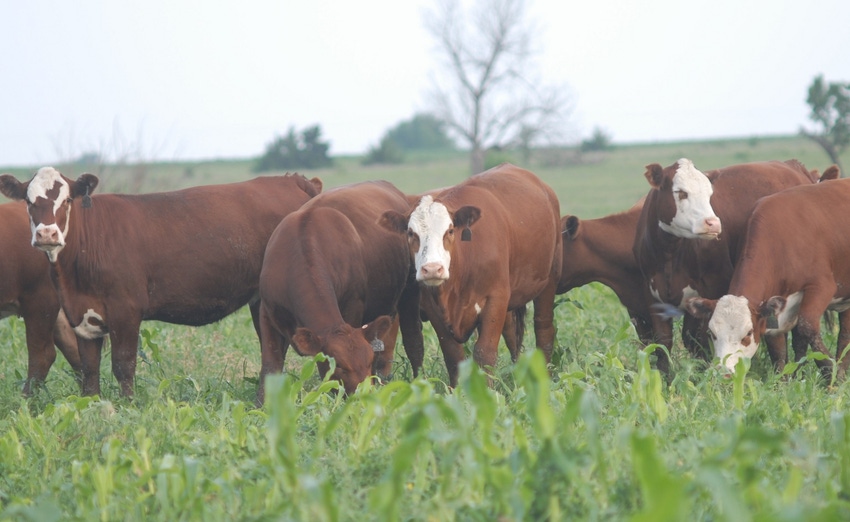Here’s the skinny on USDA’s COVID-19 financial relief for cattle growers.

On Tuesday, May 26, USDA’s Farm Service Agency (FSA) began accepting applications for the $16 billion Coronavirus Food Assistance Program (CFAP) from cattle producers.
This is part of the larger relief effort for agricultural producers who suffered a 5% or greater price loss and who are facing significant marketing costs due to the COVID-19 pandemic. Eligible commodities include cattle, hogs, dairy, specialty crops and row crops.
Checks will be issued within a week of receiving applications, and David Schemm, USDA FSA Kansas State executive director, said because of USDA retaining 20% of the total funds he doesn’t anticipate funding will run out for the program. “It’s not necessary to run into offices to sign up for fear of funding running out,” he said.
The direct support and payments will be drawn from two possible funding sources. The first source of funding is $9.5 billion in appropriated funding provided in the Coronavirus Aid, Relief & Economic Stability (CARES) Act to compensate farmers for losses due to price declines that occurred between mid-January 2020 and mid-April 2020 and provides support for specialty crops for product that had been shipped from the farm between the same time period but subsequently spoiled due to loss of marketing channels. The second funding source uses the Commodity Credit Corp. Charter Act to compensate producers for $6.5 billion in losses due to ongoing market disruptions.
The total payment will be calculated using the sum of the producer’s number of livestock sold between Jan. 15 and April 15, 2020, multiplied by the payment rates per head, and the highest inventory number of livestock between April 16 and May 14, 2020, multiplied by the payment rate per head.
Producers must provide the following information for CFAP:
Total sales of eligible livestock, by species and by class, between Jan. 15 and April 15, 2020, of inventory owned as of Jan. 15, 2020, including any offspring of that inventory, and
The highest inventory of eligible livestock, by species and by class, between April 16 and May 14, 2020.
According to the payment rate breakdown, producers will receive a split rate for the CARES Act payment rate and a CCC payment rate.
As an example, if a cattle operator sold 500 head of cattle from Jan. 15 to April 15, the CARES Act portion of the payment is $214 per head or $107,000. And then, by allocating for the largest inventory from April 16 to May 14 of 250 head, that is multiplied by the payment rate of $33 per head under the CCC portion for a payment of $8.250. This would bring a CFAP total payment of $115,250, of which 80% paid initially would equal $92,200.
Todd Barrows, Kansas FSA state program specialist, shared that for the inventory of cow-calf operators between April 16-May 14, the mature cattle would receive the $33 CCC payment, and the unweaned calf on its side would also receive the $33 payment as a feeder calf under 600 pounds.
Danielle Beck, National Cattlemen’s Beef Assn. executive director of government affairs, noted that one potential problem in the CFAP rule centers on how slaughter cattle are defined as having an average weight in excess of 1,400 pounds, yielding average carcass weights in excess of 800 pounds. Beck explained that slaughter weights in Texas, Oklahoma and New Mexico region for a week one rule before the rule was announced averaged 1,346 pounds, thereby potentially making cattle fed and marketed in this region between Jan. 15 and April 15 ineligible for the $214-per-head CFAP funding. "This will have a similar effect in Kansas and maybe other states," she said.
Barrows explained the 1,400-pound average will be based on a range of 1,200 pounds to 1,600 pounds.
Beck added that stockers and backgrounders are operationally better equipped to hold back cattle and wait out a better market environment (per-head, per-day costs are lower to wait out the market when grass is the primary input). "When prices tanked after COVID, several held cattle back to try to wait for prices to trend back to more seasonal norms," she said. Because many of these producers didn’t sell within the Jan. 15 to April 15 window, they won’t be eligible for the full payment value, just the $33-per-head rate for the inventory held within the April 16 to May 14 window.
About the Author(s)
You May Also Like





